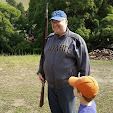Today's mail brought a package from On Military Matters. I have been building British and French armies to play all the General de Brigade scenarios from the Peninsular Wars. It seems others have had the same idea, because Partizan Press has released a scenario book focusing on this interesting theater.
The first two scenario books were pretty simple affairs, with black and white cardstock covers and black and white pages that looked like they had been photocopied. The third scenario book had a spiffy full color cover, but the inside was more of the same. This book fits right alongside the new deluxe edition of the rules. Every page is in full color, there are many pictures of beautifully painted miniatures, and there are even some uniform plates.

The book claims to include 11 scenarios, but there are actually 13 in there. Maybe they weren't counting the two all cavalry scenarios. The scenarios give unit strengths in figures, but some quick multiplication and division can modify the orders of battles for whatever rules set you wish.
1. Vimerio 1808--Vimerio Hill
This looks to be a slugfest, with not a single cavalryman in sight. Requires 302 British infantry, 3 British guns, 390 French infantry, 7 French guns.
2. Vimerio 1808--Action at Ventosa
This is a reprint of the scenario from the 2nd edition of the rules. Requires 270 British infantry, 2 British guns, 276 French infantry, 12 French cavalry, 3 French guns.
3. Talavera 1809--Battle for the Medellin
Here's your first chance to field some Spanish troops. The French force is entirely made up of minor allies. Requires 160 British infantry, 3 British guns, 72 Spanish infantry, 18 Spanish cavalry, 2 Spanish guns, 318 French allied infantry, 6 French guns.
4. Talavera 1809--Battle for the Redoubt
This is the first really large battle in the scenario book. The French are trying to wrest control of the high ground from a strong Allied force. Requires 314 British infantry, 84 British cavalry, 6 British guns, 120 Spanish infantry, 36 Spanish cavalry, 2 Spanish guns, 444 French infantry, 96 French cavalry, 17 French guns.
5. Busaco 1810--Reynier's Assault
The first battle that features the Portuguese, this is another all infantry and artillery affair. Requires 154 British infantry, 3 British guns, 234 Portuguese infantry, 2 Portuguese guns, 546 French infantry, 4 French guns.
6. Busaco 1810--Ney's Assault
The French have their work cut out for them as they attack a well positioned British force with a very narrow approach area. Requires 116 British infantry, 6 British guns, 270 Portuguese infantry, 3 Portuguese guns, 606 French infantry, 6 French guns.
7. Usagre 1811--Shadow of Albuera
This is an all cavalry affair and should be a fun change of pace from the infantry shootouts. Requires 56 British cavalry, 3 British guns, 36 Portuguese cavalry, 12 Spanish cavalry, 156 French cavalry, 3 French guns.
8. Villagarcia 1812--Prelude to Salamanca
This is the second of the book's all-cavalry battles, and this one really is all cavalry. There's not even a horse battery in sight! Requires 108 British cavalry, 90 French cavalry.
9. Salamanca 1812--Clausel's Counterattack
This sharp action has little terrain, just two bald knolls. Requires 276 British infantry, 6 British guns, 234 Portuguese infantry, 576 French infantry, 36 French cavalry, 4 French guns.
10. Salamanca 1812--The French Rearguard
French infantry on high ground fight a delaying action against a much larger Allied force. Requires 228 British infantry, 28 British cavalry, 6 British guns, 108 Portuguese infantry, 264 French infantry, 5 French guns.
11. Vittoria 1813--The Hill of Arinez
This battle, the largest scenario in the book, sees a mixed French and Spanish force attempting to hold a prominent hill against an Allied attack. Requires 504 British infantry, 102 British cavalry, 9 British guns, 222 Portuguese infantry, 408 French infantry, 48 French cavalry, 13 French guns, 72 Franco-Spanish infantry, 54 Franco-Spanish cavalry.
12. Sorauren 1813--Cole's Ridge
In this scenario the French attack a British held ridge line. There is a good chance for some urban combat if the French attempt to flank the British position. Requires 234 British infantry, 64 Spanish infantry, 120 Portuguese infantry, 690 French infantry, 2 French guns.
13. Toulouse 1814--Beresford's Attack
Allied forces attempt to carry French redoubts set on a high ridge. Every British army I have ever seen has loads of highlanders and rockets, but this is the only scenario that includes either. Requires 286 British infantry, 36 British cavalry, 2 British rockets, 126 Portuguese infantry, 372 French infantry, 36 French cavalry, 6 French guns.

As you see from the list above, there is quite a bit of variety in these scenarios, both in size and the details of the engagements. Some of the scenarios may work with 28mm miniatures, but most seem designed for 15mm. I don't know anyone who could field 690 French infantry in 28mm! With 15mm basing, the scenarios are designed for a 4' by 6' table.
This is one of the better scenario books I've seen, and I've seen quite a few. For an outlay of $30, this should keep me busy for some time. If Partizan ever publishes a similar scenario book for the 1809 campaign in Austria, the rest of my miniatures will go into storage for a few years as I paint and play my way through every battle.
































